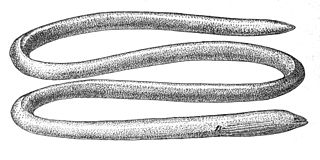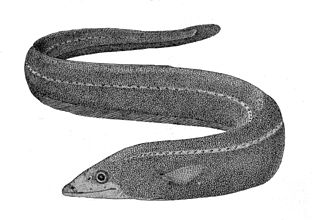Caecula is a genus of eels in the snake eel family Ophichthidae. It currently contains the following species:

The Java spaghetti eel, also known as the Java thrush-eel, Java worm eel, and the black-tailed thrush eel is an eel in the family Moringuidae. It was described by Johann Jakob Kaup in 1856, originally under the genus Aphthalmichthys. It is a tropical, marine eel which is known from the Indo-Pacific, including East Africa, the Tuamoto Islands, the Ryukyu Islands, and Micronesia. It is a burrowing species which inhabits reefs at a depth range of 2–15 m. Males can reach a maximum total length of 120 cm.
The Indo-Pacific slender worm-eel is an eel in the family Ophichthidae. It was described by Pieter Bleeker in 1857. It is a marine, tropical eel which is known from the Indo-Pacific, including the Red Sea, East Africa, the Line Islands, the Society Islands, Johnston Island, Japan, Rapa Iti, Micronesia, and the southern Great Barrier Reef. It forms burrows in inshore sediments of loose gravel and sand. Males can reach a maximum total length of 38 centimetres (15 in).

The sooty eel is an eel in the family Ophichthidae. It was described by David Starr Jordan in 1884, originally under the genus Caecula. It is a marine, subtropical eel which is known from the western Atlantic Ocean, including North Carolina and Florida, USA, and the Gulf of Mexico. It dwells at a depth range of 0 to 27 metres. Males can reach a maximum total length of 70 centimetres (2.3 ft).
The finny snake eel is an eel in the family Ophichthidae. It was described by Martin Vahl in 1794. It is a marine, tropical eel which is known from the Indian Ocean, including southern India. It is known to inhabit inshore areas of turbid waters and estuaries, though not specifically for breeding purposes. Males can reach a maximum total length of 30 centimetres, but more commonly reach a TL of 20 cm.
Callechelys leucoptera is an eel in the family Ophichthidae. It was described by Jean Cadenat in 1954. It is a tropical, marine eel which is known from the eastern Atlantic Ocean, including Senegal to Côte d'Ivoire. It is known to dwell at a depth of 45 metres. It inhabits shallow waters where it forms burrows in the sand, which are sometimes exposed during low tide. Males can reach a maximum total length of 73 centimetres, but more commonly reach a TL of 50 centimetres.
Dalophis multidentatus is an eel in the family Ophichthidae. It was described by Jacques Blache and Marie-Louise Bauchot in 1972. It is known from a single specimen collected from the Saloum River in Senegal, in the eastern Atlantic Ocean. It is known through this specimen to form burrows in sand or mud on the continental shelf, and to dwell at a depth of 50 m (160 ft). Males are able to reach a total length of 15.3 cm (6.0 in).
Ethadophis epinepheli is an eel in the family Ophichthidae. It was described by Jacques Blache and Marie-Louise Bauchot in 1972. It is a tropical, marine eel which is known from a single specimen recovered from the stomach of a grouper in Senegal, in the eastern Atlantic Ocean. It is known to reach a total length of 42.4 centimetres.
Hemerorhinus opici is an eel in the family Ophichthidae. It was described by Jacques Blache and Marie-Louise Bauchot in 1972. It is a marine, tropical eel which is known from the eastern Atlantic Ocean, including Senegal and Angola. It inhabits shallow waters near to shore, and forms burrows in sand and mud substrates. Males can reach a maximum total length of 32.5 centimetres (12.8 in).
Lamnostoma taylori is an eel in the family Ophichthidae. It was described by Albert William Herre in 1923, originally under the genus Caecula. It is a tropical, freshwater eel which is known from the Philippines in Asia, where it inhabits rivers near the sea. Males can reach a maximum standard length of 16.4 centimetres (6.5 in).

The saddled snake-eel is an eel in the family Ophichthidae. It was described by George Tradescant Lay and Edward Turner Bennett in 1839, originally under the genus Ophisurus. It is a marine, tropical eel which is known from the Indo-Pacific and southeastern Atlantic Ocean, including East and South Africa, the Hawaiian Islands, the Marquesan Islands, the Mangaréva islands, Japan, and Australia. It dwells at a depth range of 0 to 70 metres, most often around 0 to 10 metres, and inhabits lagoons and reefs, in which it forms burrows in beds of seagrass and sandy areas. Males can reach a maximum total length of 66 centimetres (2.17 ft).

The goldspotted eel, also known as the goldspotted snake eel or the dark-spotted snake eel, is an eel in the family Ophichthidae. It was described by Charles Alexandre Lesueur in 1825, originally under the genus Muraenophis. It is a marine, tropical eel which is known from the western and eastern Atlantic Ocean, including Bermuda, southern Florida, USA; the Bahamas, Santa Catarina, and Brazil. It dwells at a maximum depth of 15 metres (49 ft), and inhabits rocky and coral reefs. Males can reach a maximum total length of 110 centimetres (3.6 ft).
The African spoon-nose eel is an eel in the family Ophichthidae. It was described by John Richardson in 1848. It is a tropical, marine eel which is known from the eastern Atlantic Ocean, including Mauritania and Namibia. It is known to dwell at an approximate depth of 40 metres, and inhabits lagoons and coastal waters. It leads a benthic lifestyle, burrowing into sand and mud. Males can reach a maximum total length of 140 centimetres, but more commonly reach a TL of 80 cm.

The dark-shouldered snake eel is an eel in the family Ophichthidae. It was described by Pieter Bleeker in 1864. It is a tropical, marine eel which is known from the Pacific Ocean, including the East Indies, the Society Islands, the Mariana Islands, Queensland, the Marshall Islands, Micronesia, Japan, and India. It dwells at a depth range of 2–15 metres, and inhabits reefs. It forms burrows in mud and sand, and forages during the night. Males can reach a maximum total length of 115 centimetres.

The rice-paddy eel is an eel in the family Ophichthidae. It was described by Francis Buchanan-Hamilton in 1822, originally in the genus Ophisurus. It is a tropical, marine eel which is known from the Indo-West Pacific, including Somalia, Tanzania, South Africa, India, Pakistan, Sri Lanka, Indonesia, Polynesia, Australia, Bangladesh, Cambodia, Kenya, Madagascar, the Philippines, Malaysia, Mozambique, Seychelles, Saudi Arabia, Taiwan, China, Thailand, Vietnam, and southern Yemen. It is an anadromous species and spawns in freshwater, often in rice paddies during the rainy season, earning it its common name. It also spends time in lagoons, estuaries and coastal rivers, in which it lives in burrows in the river bottom and bank. Males can reach a maximum total length (TL) of 100 centimetres, but more commonly reach a TL of 70 cm.

The Marble-toothed snake-eel is an eel in the family Ophichthidae. It was described by Charles Henry Gilbert in 1898. It is a marine, tropical eel which is known from the eastern central and southeastern Pacific Ocean, including Costa Rica, Colombia, Panama and Ecuador. It dwells in shallow waters at a maximum depth of 10 metres (33 ft), and inhabits sand and mud sediments and mangroves. Males can reach a maximum total length of 68 centimetres (27 in).
Yirrkala maculata is an eel in the family Ophichthidae. It was described by Wolfgang Klausewitz in 1964, originally under the genus Caecula. It is a marine, tropical eel which is known from the western central Pacific Ocean.

The Bean's sawtooth eel is an eel in the family Serrivomeridae. It was described by Theodore Gill and John Adam Ryder in 1883. It is a marine, deep water-dwelling eel which is known from throughout the Atlantic Ocean, the Indian Ocean, and the Western Pacific Ocean, including Iceland, South Africa, Réunion, and Australia. It dwells at a depth range of 0–5,998 metres (0–19,680 ft), and leads a solitary lifestyle. It migrates vertically at night. Males can reach a maximum total length of 78-80 centimetres, making it the largest sawtooth eel.

The shortdorsal cutthroat eel is an eel in the family Synaphobranchidae. It was described by Albert Günther in 1887. It is a marine, deep water-dwelling eel which is known from the Indo-Pacific and western central Atlantic Ocean, including Zanzibar, Maldives, Australia, Japan, Suriname, and the Gulf of Mexico. It dwells at a depth range of 900 to 3,000 metres, most often between 1,000 to 2,500 metres, and leads a benthic lifestyle, inhabiting the continental slope. Males can reach a maximum total length of 111 centimetres (44 in).

The Kaup's arrowtooth eel is an eel in the family Synaphobranchidae. It was described by James Yate Johnson in 1862. It is a marine, deep water-dwelling eel which is known from the Indo-Western Pacific and eastern and western Atlantic Ocean, including the Faroe Islands, Iceland, Cape Verde, the Western Sahara, Nigeria, Namibia, South Africa, Greenland, France, Saint Pierre and Miquelon, the United Kingdom, Ireland, the Philippines, Portugal, Spain, the Bahamas, Brazil, Canada, Cuba, Japan, Australia, Mauritania, Morocco, and Hawaii. It dwells at a depth range of 120 to 4,800 metres, most often between 400 and 2,200 metres, and inhabits the upper abyssal zone on the continental slope. It is intolerant of the temperatures of higher waters. Males can reach a maximum total length of 100 centimetres (39 in).









